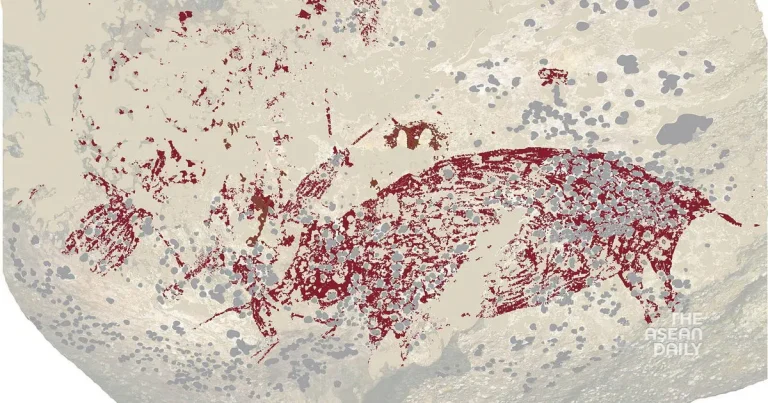4-7-2024 (JAKARTA) In a groundbreaking discovery that challenges our understanding of human cognitive evolution, archaeologists have unearthed what is believed to be the oldest known narrative artwork created by human hands. The humble cave painting, found in Indonesia and dating back more than 51,000 years, depicts three figures surrounding a large red pig, offering a tantalising glimpse into the early origins of human storytelling.
Maxime Aubert, an archaeologist from Griffith University in Australia and co-author of the study published in Nature, hailed the find as “the oldest evidence of storytelling”. This discovery surpasses the previous record holder, a hunting scene found in a nearby Indonesian cave, which was estimated to be nearly 44,000 years old.
The team employed a novel laser ablation technique to date the artwork, which proved to be more precise, efficient, and cost-effective than traditional uranium series dating methods. This innovative approach allowed the researchers to push past the 50,000-year barrier for the first time in dating prehistoric art.
The implications of this discovery are profound, suggesting that the ability to convey complex narratives through visual media may have emerged much earlier in human history than previously thought. Adam Brumm, another co-author of the study, emphasised the significance of the find, stating that it “suggests storytelling was a much older part of human history… than previously thought”.
The painting itself, while in poor condition, offers a tantalising glimpse into the minds of our ancient ancestors. Although the exact nature of the scene remains unclear, it is speculated that the artwork may have been created by the first group of humans who migrated through Southeast Asia en route to Australia around 65,000 years ago.
This discovery challenges the conventional timeline of human artistic development. While simple lines and patterns made in ochre, dating back 100,000 years, have been found in South Africa, there has been a significant gap in the archaeological record until these Indonesian cave paintings emerged some 50,000 years later.
The find also raises questions about the development of narrative art in other parts of the world. Previously, the earliest known narrative art was thought to have originated in Europe, with the famous “lion man” statue found in Germany dating to around 40,000 years ago.
Chris Stringer, an anthropologist at London’s Natural History Museum who was not involved in the research, described the dating of the Indonesian cave art as “quite provocative”. He suggested that this discovery reinforces the idea that representational art may have first been produced in Africa before 50,000 years ago, with the concept spreading as our species migrated across the globe.




